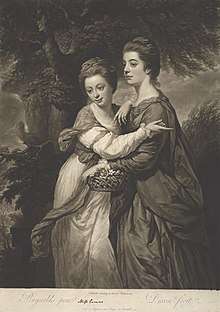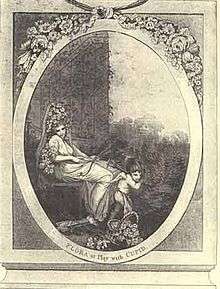Emma Crewe
Emma Crewe (1780–1850)[1] was a "gifted" amateur artist. Along with Diana Beauclerk (1734–1808) and Elizabeth Templetown (1747–1823), she contributed designs in "Romantic style" to Josiah Wedgwood for reproduction in his studio in Rome.[2] She was the daughter of John Crewe, 1st Baron Crewe[3] and his wife Frances Crewe, Lady Crewe.
Emma Crewe | |
|---|---|
 Miss Emma Crewe and Miss Elizabeth Crewe by John Dixon after Sir Joshua Reynolds | |
| Born | 1780 |
| Died | 1850 (aged 69–70) |
| Nationality | British |

Crewe was criticised in Richard Polwhele's The Unsex'd Females, for having painted the Frontispiece to Erasmus Darwin's The Loves of the Plants: "There is a charming delicacy in most of the pictures of Miss Emma Crewe; though I think, in her "Flora at play with Cupid," … she has rather overstepped the modesty of nature, by giving the portrait an air of voluptuousness too luxuriously melting."[4]
Family
She married in 1809 Foster Cunliffe-Offley.[5] Following the death of her father, Emma became the guardian of her youngest niece Annabella Hungerford Crewe, the daughter of her only brother, John Crewe, 2nd Baron Crewe, who was estranged from the family.[6] Emma and Annabella lived together until Emma's death on 15 February 1850, dividing their time between London and Madeley Manor in Staffordshire and travelling extensively on the continent after the death of Foster Cunliffe Offley in 1832.[7]
After Emma's death Annabella erected a fountain in her aunt’s memory in Madeley, Staffordshire and donated the piece of land on which it stood to the poor to use as allotments.[8] The allotments and memorial still survive on Manor Road in Madeley.[9] In 1851 Annabella married Richard Monckton Milnes, 1st Baron Houghton.
Notes
- "Miss Emma Crewe and Miss Elizabeth Crewe". Yale Center for British Art. The Paul Mellon Centre for Studies in British Art. Retrieved 11 August 2017.
- Reilly, Robin. "Wedgwood, Josiah (1730–1795)". Oxford Dictionary of National Biography (online ed.). Oxford University Press. doi:10.1093/ref:odnb/28966. (Subscription or UK public library membership required.)
- Cowper, William; King, James; Ryskamp, Charles (1986-12-04). The Letters and Prose Writings of William Cowper: Prose 1756-c. 1799 and cumulative index. Clarendon Press. p. 90. ISBN 9780198126904.
- Richard Polwhele, The Unsex'd Females: A Poem, Addressed to the Author of the Pursuits of Literature. London: Printed for Cadell and Davies, in the Strand. 1798. (Etext Archived 2007-06-03 at the Wayback Machine, UofVirginia)
- Pine, L. G. (1972). The New Extinct Peerage 1884-1971: Containing Extinct, Abeyant, Dormant and Suspended Peerages With Genealogies and Arms. London: Heraldry Today. p. 89. ISBN 0900455233.
- Borthwick Institute for Archives, Milnes Coates Archive: Correspondence of Emma Cunliffe Offley.
- Borthwick Institute for Archives, Milnes Coates Archive: Correspondence of Emma Cunliffe Offley and Annabella Crewe.
- Borthwick Institute for Archives, Milnes Coates Archive: Correspondence of Annabella Crewe.
- "Most of what follows is true ……".
| Wikimedia Commons has media related to Emma Crewe. |